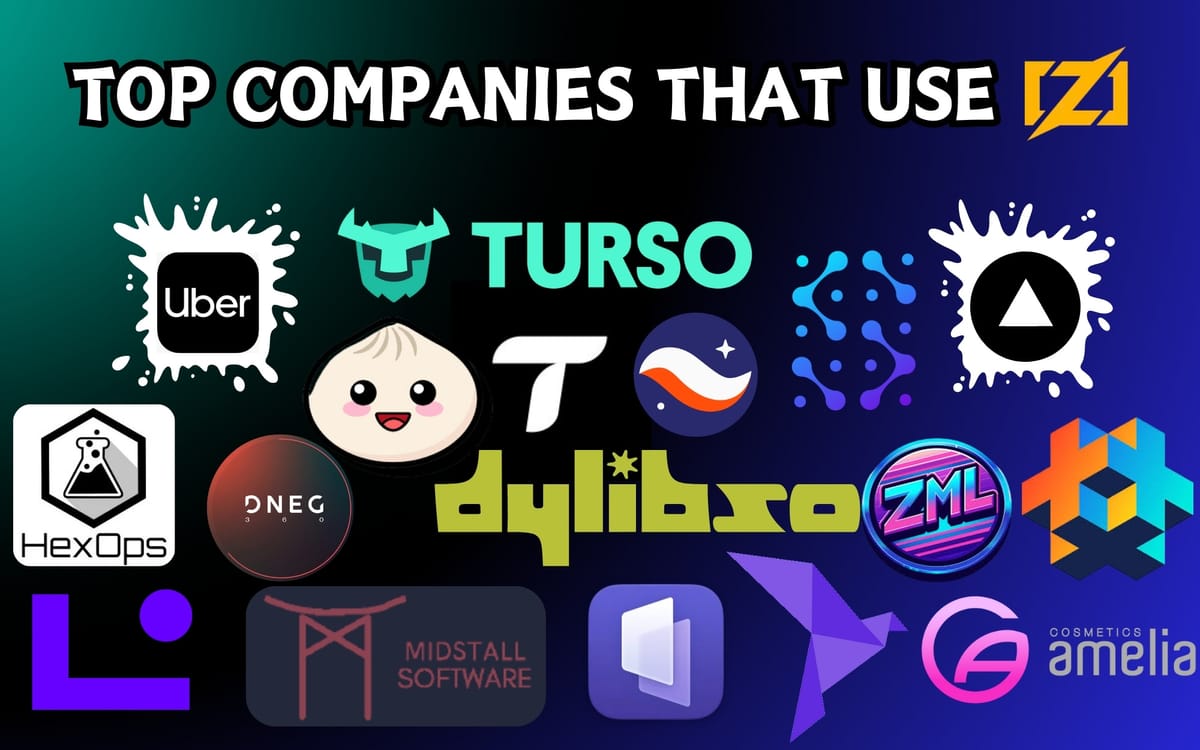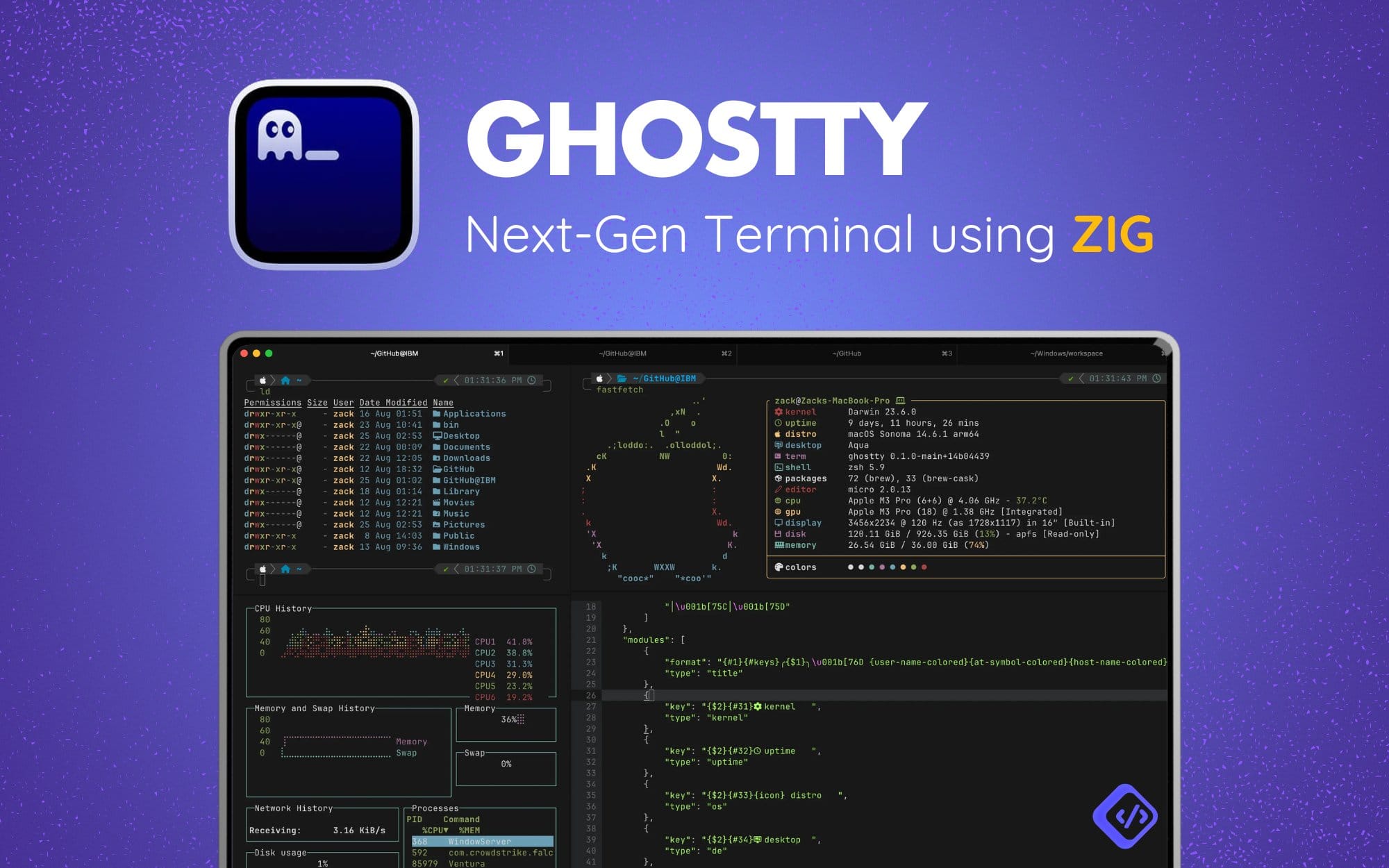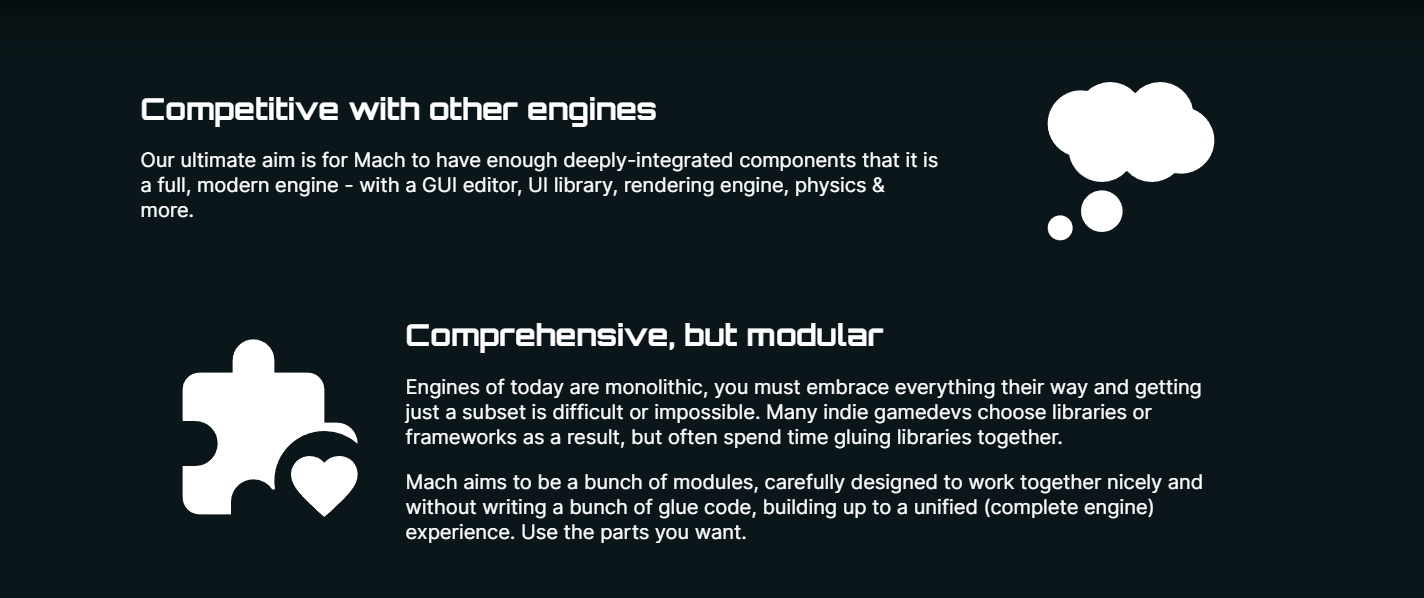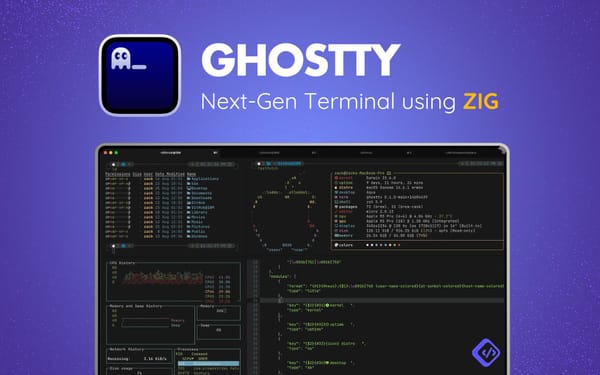Top 21 Companies using Zig in Production: Key Features & Benefits

In a world where tech powers everything from coffee machines to self driving cars one thing is clear: we need programming languages that can handle complexity without compromising safety or performance. Everyone developers goes through the pain of learning new language multiple times in his life span, just when he is searching for the best language, that sadly never exists.
The stakes are high, errors in code can cause anything from frustrating app crashes to mission critical system failures. Enter Zig the programming language that’s quietly (but quickly) changing how developers think about systems programming, and scalebale applications.
But why all the fuss? Imagine a language that gives you the low level control of C, the safety of Rust and the simplicity of Python. That’s Zig—a language that helps you build efficient, reliable and cross platform applications with minimal hassle. It’s like having the best of all worlds in one neat package.
What You’ll Read
In this post we’ll look at why Zig is the language of choice for businesses solving real world problems. Whether you’re a developer looking for better tools or a tech leader considering languages for your next big project you’re in the right place. Here’s what we’ll cover:
- How Zig solves the problems of software development: Why its performance, safety and low level control makes it a better choice than C and C++.
- Zig in action across industries: See how companies in embedded systems, game development and cloud infrastructure are using Zig to build applications.
- Why Zig is different: Cross platform support and a solid build system. We’ll go through the tools and features that make Zig a dev favorite.
If you’re sick of languages that don’t give you enough control or bury you under complexity Zig might be the answer you’ve been looking for. By the end of this post you’ll know:
- Why businesses are using Zig for production code.
- How Zig helps you write safer, faster and more maintainable code.
- Is Zig right for your next project.
So grab a coffee, sit back and let’s get into Zig—a language that’s not just keeping up with the future of software development but helping to shape it. 🚀
What is Zig
Zig programming language which is also called Ziglang is a general purpose programming language designed to solve the problems of building modern high performance software systems while being simple and reliable. Created by Andrew Kelley in 2015 Zig is a C and C++ alternative that fixes the problems of those languages with a clean modern design.
Whether you're working on embedded systems, systems programming, or application-level software, Zig is not going todisappoint you and always delivers a simpler, safer, and more efficient development experience.
Why Zig Matters
Zig strikes a compelling balance between the performance and low-level control of languages like C and C++ with the safety and modern features of contemporary programming languages. This unique blend makes it an attractive choice for a wide range of programming tools.
- Performance That’ll Blow Your Mind: Zig lets you fine-tune your code down to the byte, making it lightning-fast.
- Memory Safety: Say goodbye to null pointer bugs and memory leaks, Zig makes the developers life less terrifing.
- Cross-Platform Magic: Compile once, run everywhere.
- Simple Syntax, Big Results: Writing in Zig feels like writing in a modern, elegant language—but with all the power of C.
You can also check out a Detailed Compression of Memory Safety in C++ vs Rust vs Zig on Medium.
In today’s software world, Zig is a safe, high performance and versatile language that makes development easier and has a lot of features. It’s raising the bar for what we can expect from a modern language. Here’s why Zig stands out:
Safety First, Performance Always
Not like C or C++ where you have low level control and no modern safety features:
- Null safety: No null pointer dereferencing.
- Bounds checking: No out of bounds memory access.
- Ownership management: Simplifies memory handling.
So you can write stable and reliable code without performance loss. Zig’s compile time optimizations let you generate highly efficient machine code and have control over memory and hardware. In other words, speed and safety—no compromises!
Modernity Meets Legacy
Zig isn’t here to replace the old but to build upon it. Its C compatibility lets you:
- Call C libraries directly, decades of proven code.
- Integrate with existing systems, no time and resources wasted.
Also Zig’s cross platform capabilities means your applications will work the same across different operating systems and architectures, whether you’re targeting Linux, macOS, Windows or embedded devices.
Tooling That Works For You
Zig’s tooling ecosystem is designed to make development easier:
Zig Build System
No more Makefiles or custom scripts—zig build does everything, from compiling to managing dependencies. Key benefits:
- Unified build management for projects.
- Simplified configurations, less errors.
- Easy integration with 3rd party libraries.
Package Manager
The Zig package manager lets you import and manage dependencies with ease. With growing library support you can develop faster without the dependency headaches.
Documentation
Zig has well maintained and beginner friendly documentation. And example driven tutorials for newbies to get started📚
An Expanding Library Ecosystem
Zig’s ecosystem is growing fast, so it’s good for many applications:
- Cross platform development: Write once, run everywhere.
- Versatile libraries: Networking, cryptography, file handling.
- Embedded and IoT: Good for industries that need lightweight and high performance code.
With developers contributing, the library collection is growing every day.
A Community That Cares
The strength of Zig is its community. From Reddit to Hacker News, Zig enthusiasts are:
- Discussing new features and real world use cases.
- Contributing code, libraries and fixes.
- Newbies welcome!
Zig is open source so everyone’s voice matters and the future is shaped by the people who use it.
Why Zig Matters for Developers
Zig simplifies the complexity of modern software development while giving you unparalleled control over performance and safety. It’s not just a language but instead an ecosystem designed to help programmers to focus on building great software, whether it’s a CLI tool, or a ui library, or even a high-performance application.
Key Takeaways
- Safety meets speed: Zig helps to write reliable code without worrying about the performance.
- Built for the modern era: Cross-platform support and C compatibility make Zig practical for real-world use which helps to faster the adoption time.
- A complete toolkit: From the in build system to the package manager tool, Zig makes development smoother.
- Active community: Learn, contribute, share your progress with others and grow alongside other Zig developers.
With its growing ecosystem, powerful tooling, and active community, Zig is becoming the language of choice for developers who demand safety, performance, and usability. Whether your goal is building systems, libraries, or applications, worry not Zig is ready to power your next big project.
System-Level Development & Performance-Critical Applications
Zig is used by many big companies. Let’s see some notable applications built with this language. Zig’s system programming and performance features have led to its adoption by many companies. These projects will show how Zig can be used in applications that need speed, efficiency and low-level control.
Uber
Uber has added Zig to their infrastructure to enable cross compilation, especially for deploying services on Arm64 architecture.
In May 2023, Uber announced this, and showed how they developed a hermetic (system independent) build toolchain powered by Zig. This toolchain allows Uber to compile C and C++ code on multiple platforms and have consistent builds regardless of the host system.

To support this Uber open-sourced the ‘hermetic_cc_toolchain’, a Bazel C/C++ toolchain built on top of Zig’s compiler. This toolchain makes cross compilation easier and is available on GitHub.
Uber also has a support contract with the Zig Software Foundation to ensure issues are fixed quickly and to contribute to the development of Zig. By using Zig Uber can deploy software across multiple architectures more efficiently, they are committed to using modern open-source technologies to optimize their infrastructure.
Vercel
Vercel has strategically integrated the Zig programming language into its build system to boost performance and efficiency. This integration was particularly pivotal during the incremental migration of Turborepo—a high-performance build system for JavaScript and TypeScript—from Go to Rust.
In this migration Vercel used a “Rust-Go-Rust sandwich” architecture where a Rust binary calls a Go binary which in turn statically links Rust libraries. Zig was key in this process by allowing cross compilation, so Vercel could create a hermetic, multi-platform build toolchain.
By using Zig Vercel got faster and more predictable builds and more scalable and performant deployment infrastructure. This shows Vercel’s commitment to modern languages and tools to deliver optimized and efficient services.
Starknet
Starknet uses Zig to implement the Cairo Virtual Machine (CVM) which runs smart contracts on the blockchain. Zig’s low level control, memory safety and performance optimizations addresses scalability and security issues.
Key Advantages:
- Performance Boost: Compile time execution reduces runtime overhead, faster smart contract execution.
- Security: bounds checking and null safety to prevent memory corruption and make it more reliable.
This makes the CVM fast, secure and able to handle decentralized apps.
Ghostty Terminal
Ghostty is a GPU accelerated cross-platform terminal emulator and needed a language that balanced performance with safety. Zig programming language was the perfect option.
Instead of Rust’s complicated borrow checker, Zig has a simpler approach to memory management and no null pointers. So Ghostty can have C like performance without losing your mind. You can read our full article where we shared all reasons for Ghostty Terminal to choose Zig language over Golang and Rust.

Zig compiles directly to machine code and has SIMD instructions so it extracts every last bit of power from the hardware. It is fast on both macOS and Linux. And with it’s clean syntax and simple error handling the Ghostty team can focus on building an amazing user experience instead of fighting the compiler.
Sprial
Sprial uses Zig to solve the problem of building scalable high-performance systems. Zig lets you talk to the hardware directly and eliminates the problems of traditional low-level languages. By using Zig’s compile time execution Sprial reduces runtime overhead and optimizes their code for better system performance.
Axiom
Axiom has a Zig library for HyperLogLog (HLL) cardinality estimation. HLL is used to estimate the number of unique elements in large datasets. This is based on the LogLog-Beta algorithm which is known for being efficient and simple. By using Zig Axiom gets a balance between low level control and performance optimization so you get accurate and fast estimates.
TigerBeetle
TigerBeetle is a financial transactions database designed for mission critical safety and performance. The team chose Zig for several reasons:
- C ABI Compatibility: Allows you to embed the TigerBeetle leader library or network client into any language, just like you can with the SQLite library.
- Memory Safety: Features like bounds checking and checked arithmetic provide more memory safety than C.
- Explicit Memory Management: Allows control over memory layout, alignment and padding, reducing cache misses and unaligned accesses.
For more information visit TigerBeetle’s documentation:
Turso
Turso is a serverless edge database based on a fork of SQLite and has been experimenting with Zig to move data to the edge. The team likes Zig’s simplicity and the comptime feature which allows you to run arbitrary code at compile time.
However they also noted some challenges, like the lack of Rust-style destructors which can lead to memory leaks if not managed carefully. Despite these challenges Zig’s explicitness and performance optimizations are a valuable addition to Turso’s toolchain.
Also Zig’s cross platform capabilities allows Turso to deploy their database across multiple architectures so they can run everywhere and perform the same.
ZML
ZML uses Zig to build a high performance AI inference stack for efficient and memory safe machine learning. By using Zig’s low level control and compile time optimizations ZML can run AI models fast with minimal overhead. This means complex algorithms can process large datasets quickly and robustly.
Dylibso
Dylibso builds dynamic libraries and uses Zig to build cross platform solutions. Zig’s explicit memory management and cross compilation capabilities allows Dylibso to build libraries that work the same across different operating systems and architectures.
For example their XTP CLI has a test harness to run Extism tests and supports multiple languages including Zig. This makes it easy to integrate and test plugins.
Syndica
Syndica has released ‘Sig’, a Solana validator client written in Zig, optimized for Reads-Per-Second (RPS) performance. Since 96% of all calls to a node are reads Sig focuses on optimizing read operations to improve user experience. By using Zig Syndica is adding client diversity and fault tolerance to the Solana network.
Web & Cloud-Native Apps Love Zig
Zig is known for its performance, memory safety and low-level control, so it’s no surprise it’s a valuable asset in building web and cloud-native apps. Let’s see how Bun, Ameli and Tuple are using Zig to power their platforms.
Bun
Bun is a modern JavaScript runtime that’s a drop-in replacement for Node.js. Built with Zig, Bun extends the JavaScriptCore engine (the same engine used in Safari) to give you blazing speed and efficiency. This allows Bun to startup up to 4x faster than Node.js on Linux.
By using Zig’s low-levelness, Bun gives you a native bundler, transpiler, task runner and npm client all in one. This makes development easier and faster, so if you want efficiency and speed in your JavaScript and TypeScript apps, Bun is the way to go.

By using Zig’s low-levelness, Bun gives you a native bundler, transpiler, task runner and npm client all in one. This makes development easier and faster, so if you want efficiency and speed in your JavaScript and TypeScript apps, Bun is the way to go.
Ameli
Ameli, a Korean makeup company, built a virtual makeup try-on feature that runs in the browser with WebAssembly. By using Zig, Ameli’s dev team was able to get rid of Emscripten, reduce compilation time and write a lean codebase with minimal overhead. This way all image processing is done locally on the end device so users get a seamless and responsive experience without compromising privacy.
Tuple
Tuple is a remote pair programming app for macOS and Windows, with high-res screen sharing and low-latency remote control.
While the exact components built in Zig are not public, Tuple’s focus on performance and efficiency matches Zig’s strengths in low-level control and compile-time optimizations. So it’s likely Zig is helping Tuple give developers a smooth and responsive experience when working remotely.
By using Zig in their workflows these companies shows, how you can build fast, secure and scalable web and cloud-native apps.
Zig's growing demand for Game Development and Graphics
Zig’s performance, low-level control and memory safety makes it a great choice for game development infect better than other popular languages. With help of low level control game developers can optimize the game for different hardware modules. This being the reason, it is gaining popularity among game developers.
Let’s see how Hexops, DNEG and Defold are using Zig for their projects, this will also help me to explain why I say Zig is the ideal language in this niche.
Hexops
Hexops is working on the Mach engine, a game engine and graphics toolkit fully written in Zig. This game engine aims to provide high performance, truly cross platform, a powerful and modular solutions for building games, visualizations, and desktop/mobile GUI applications in upcoming future.

With Zig we have fine grained control over system resources so development is more efficient and we can create high performance game engines. The Mach engine is open source and available on GitHub.
DNEG
DNEG is a visual effects (VFX) and animation studio and they are known for pushing the boundaries of technology to improve their rendering.
While DNEG don’t disclose specific details about their use of Zig, the fact they are always adopting the latest tech makes it clear they are focused on performance and efficiency in their pipeline. Their website has more info on their tech.
Defold
Defold is a cross platform game engine and they have managed to get Zig to work as native extensions. This allows developers to optimize critical parts of the game engine that requires low level memory control and high performance execution. An example project on how to write native extensions with Zig is available on GitHub.
By using Zig these companies are showing that you can have smoother, more responsive and more reliable gaming with high quality graphics. Better overall.
Zig: The Secret Sauce for Compilers and New Programming Languages
If you're into the world of compilers and language design, Zig is the shiny new tool you’ll want to put in your arsenal. With its mix of low-level control, metaprogramming superpowers, and rock-solid memory safety, Zig is becoming a go-to choice for building performant and reliable compilers. It’s like the Swiss Army knife of programming languages, but cooler. Let’s break it down with some fun examples!
RDDL Foundation: Building Relationships... But for Data!
Ever wondered how you can define complex data structures and their relationships without giving your compiler a nervous breakdown? That’s where RDDL Foundation comes in. They’re crafting the RDDL language, and guess what? Zig is their secret weapon.
- What’s the deal?
- RDDL juggles complex data manipulations, and Zig ensures memory safety like a boss. Null pointers? Out-of-bounds errors? Forget about it.
- Performance on steroids: RDDL needs to execute real-time operations, and Zig’s manual memory management makes everything zippy.
Zig helps RDDL stay fast, safe, and everywhere at once.
Zig Software Foundation: Eating Their Own Dog Food
The Zig Software Foundation isn’t just developing the language; they’re also using Zig to build Zig. That’s meta and genius at the same time.
- Why Zig for Zig?
- It’s the perfect way to showcase Zig’s core strengths: speed, simplicity, and safety.
- Their internal tools benefit from compile-time execution, ensuring they’re as optimized as possible.
- Every feature gets real-world testing before it lands in your hands. Talk about quality control!
The foundation uses Zig to prove how awesome Zig is—like flexing in a gym mirror.
Roc Programming Language Foundation
If you haven’t heard of Roc, it’s a functional programming language that’s super slick and fast. To make that happen, the Roc folks used Zig for their compiler builtins and low level components.
- Why Zig is great for Roc:
- Zig’s memory control is fine grained so Roc’s compiler is as fast as your morning coffee.
- Roc gets Zig’s memory safety so no more buffer overflows.
- Zig’s cross platform powers means Roc works on Linux, macOS and Windows.
Roc uses Zig to keep things functional, fast, and flawless.
In each case, RDDL Foundation, Zig Software Foundation and Roc Programming Language Foundation use Zig to solve performance, memory safety and cross platform problems.
Zig Isn’t Just for Geeks (But It Helps)
Zig’s not just for compiler geeks and language enthusiasts—though it’s awesome for them. It’s also a great general purpose tool for:
- Command line utilities: Want a super fast CLI tool? Zig’s got you covered.
- System utilities: Manage system resources without breaking a sweat.
- C/C++ Interop: Zig’s compatibility makes working with existing codebases easy.
Zig’s growing library and tool ecosystem also makes it suitable for general development.
General Development Using Zig
Zig isn’t just for niche use cases like compilers or game engines; it’s a general purpose programming language! With performance, memory safety and a clean syntax Zig is becoming the language of choice for system level programming, utilities and powerful libraries.
Zig’s design makes it great for general purpose development when performance and reliability are non negotiable. One company that’s doing just that is Midstall Software. Let’s see how they’re using Zig to build robust high performance solutions.
Midstall Software: Performance and Reliability Redefined
Midstall Software builds performance-critical applications and system-level libraries and Zig is at the heart of it. Here’s how Zig helps Midstall solve some of the toughest problems in software development:
1. Performance
Midstall’s projects need to be fast. Zig’s manual memory management and compile time code optimization means minimal runtime overhead. This is a big win for system utilities that need to talk to hardware at lightning speeds and Libraries that are the foundation for other applications where inefficiency is not allowed.
2. Memory Safety
System-level programming is hard when it comes to memory management but Zig makes it easier:
- Bounds checking so arrays don’t overflow.
- Null safety so you don’t accidentally dereference null pointers.
- Compile time error detection so issues are caught before they hit production.
For Midstall this means fewer bugs, less debugging time and happier developers.
3. Low-Level Control
Some of Midstall’s applications need to talk to hardware or custom memory management. Zig’s fine grained control over:
- Memory allocation: Developers can allocate, free and manage memory without surprises.
- CPU utilization: Zig allows developers to write highly optimized code for specific hardware.
This level of control helps Midstall deliver products that are not only fast but also tailored for their use case.
4. Cross-Platform Support
Midstall often builds for multiple platforms and Zig’s cross compilation makes this easy. Write once and deploy everywhere:
- Windows? ✅
- Linux? ✅
- macOS? ✅
This reduces development overhead and gets Midstall’s software to more people with less hassle.
Real-World Example
Midstall is building a system monitoring tool to track resource usage across devices. With Zig they can:
- Call system level APIs directly with C interop.
- Write super lightweight code that runs on old hardware.
- Ensure reliability with compile time safety checks so users don’t get crashes or memory leaks.
Here’s a simple example of Zig calling a system level API:
- Fast, safe and no heavy abstractions.
- Zig makes you address problems explicitly.
zigCopyconst std = @import("std");
pub fn main() void {
const allocator = std.heap.page_allocator;
var buffer: [1024]u8 = undefined;
// Simulate reading system data into the buffer
const bytes_read = std.os.read(0, &buffer[0], buffer.len);
if (bytes_read < 0) {
std.debug.print("Failed to read data: {}\n", .{bytes_read});
return;
}
std.debug.print("Read {} bytes: {}\n", .{bytes_read, buffer[0..bytes_read]});
}Conclusion
Zig is redefining software development with performance, security and usability. Low level control like C/C++ and modern safety features, so you can write safe and efficient code.
Companies like Uber, Vercel and TigerBeetle use Zig for performance optimization, memory safety and cross platform support. The growing ecosystem, robust tooling and active community means Zig can support many industries.
For high performance systems, embedded applications or new programming languages, Zig gives you simplicity, reliability and scalability. It’s a great choice for developers tackling hard problems.
Ready to dive into Zig? The future is fast, safe, and cross-platform—just like Zig itself.





